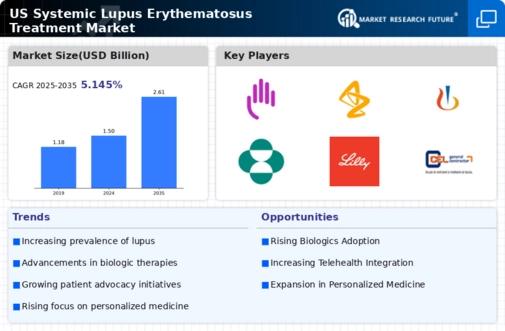Advancements in Therapeutic Options
The systemic lupus-erythematosus-treatment market is significantly influenced by advancements in therapeutic options. The introduction of novel biologic agents and targeted therapies has transformed the treatment landscape for SLE. For instance, recent approvals of medications such as belimumab and anifrolumab have provided new avenues for managing the disease. These therapies not only improve patient outcomes but also enhance the quality of life for individuals suffering from lupus. The market is projected to witness a compound annual growth rate (CAGR) of around 8% over the next few years, driven by the continuous innovation in drug development. As pharmaceutical companies invest in research and development, the systemic lupus-erythematosus-treatment market is poised for substantial growth, catering to the diverse needs of patients.
Growing Demand for Personalized Medicine
The systemic lupus-erythematosus-treatment market is increasingly driven by the growing demand for personalized medicine. Patients are seeking tailored treatment approaches that consider their unique genetic, environmental, and lifestyle factors. This shift towards personalized therapies is prompting pharmaceutical companies to invest in precision medicine strategies, which aim to optimize treatment efficacy and minimize adverse effects. As a result, the systemic lupus-erythematosus-treatment market is witnessing a surge in the development of individualized treatment plans, which are expected to improve patient adherence and outcomes. The trend towards personalized medicine is likely to reshape the market dynamics, as healthcare providers and patients alike embrace more targeted and effective treatment options.
Rising Awareness and Education Initiatives
Increased awareness and education initiatives surrounding systemic lupus erythematosus are pivotal in driving the systemic lupus-erythematosus-treatment market. Organizations and advocacy groups are actively working to educate both healthcare professionals and the general public about the disease, its symptoms, and the importance of early diagnosis. This heightened awareness leads to earlier treatment interventions, which can significantly improve patient outcomes. Moreover, educational campaigns are fostering a better understanding of the complexities of lupus, encouraging patients to seek medical advice sooner. As awareness continues to grow, the systemic lupus-erythematosus-treatment market is likely to expand, as more individuals are diagnosed and treated effectively.
Government Support and Funding for Research
Government support and funding for research into systemic lupus erythematosus play a crucial role in shaping the systemic lupus-erythematosus-treatment market. Federal agencies, such as the National Institutes of Health (NIH), allocate substantial resources towards lupus research, which facilitates the discovery of new treatment modalities. This financial backing not only accelerates the pace of clinical trials but also encourages collaboration between academic institutions and pharmaceutical companies. As a result, the systemic lupus-erythematosus-treatment market benefits from a steady influx of innovative therapies and improved treatment protocols. The ongoing commitment to funding lupus research is expected to yield significant advancements in the coming years, further enhancing the market landscape.
Increasing Prevalence of Systemic Lupus Erythematosus
The rising incidence of systemic lupus erythematosus (SLE) in the US is a critical driver for the systemic lupus-erythematosus-treatment market. Recent estimates suggest that approximately 1.5 million Americans are living with lupus, with a notable increase in diagnosed cases over the past decade. This growing patient population necessitates the development and availability of effective treatment options, thereby stimulating market growth. Furthermore, the demographic shift towards an aging population, coupled with higher awareness and improved diagnostic capabilities, contributes to the increasing prevalence of SLE. As healthcare providers become more adept at recognizing the symptoms and complexities of lupus, the demand for innovative therapies is likely to rise, further propelling the systemic lupus-erythematosus-treatment market forward.
























Leave a Comment